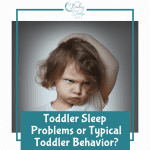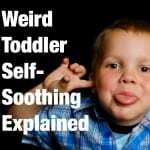
Toddler sleep regressions – what are they, when they happen, and how to help your toddler sleep? Today’s post will explain everything you need to know about toddler sleep regressions.
Baby and toddler sleep is an ever-shifting, ever-changing thing, isn’t it? Just when you think you’re done with sleep training, done with nap time drama, done with night wakings — you find out you’re not. Something happens (an illness, a bout of teething, a vacation, etc.), and everything falls apart.
And it’s so discouraging. So normal, but so very, very discouraging.
Sometimes, you can trace the blip in your little one’s sleep to an obvious factor (like a recent vacation, for example). Other times, though, the blip seems to come out of nowhere. In cases like that, you can usually blame a sleep regression.
We’ve written about sleep regressions pretty extensively, so if you’ve been reading The Baby Sleep Site for any length of time, you probably know at least a little bit about when they happen and what they are.
In today’s post, we’re going to put aside the “baby” sleep regressions (the ones that happen at 4 months and at 8, 9, or 10 months) and focus on the two toddler sleep regressions. We’ll look at when the two most common toddler sleep regressions happen, why they occur, what kinds of problems they cause, and how you can cope.
Toddler Sleep Regressions: What Are They and When Do They Happen?
Most people use the term “sleep regression” to mean that a baby or toddler, who’s been sleeping well, suddenly (often without any warning) begins waking frequently at night and/or refusing to nap during the day. These regressions usually last for some time (anywhere from 2 – 6 weeks); then, your baby or toddler’s sleep should return to its normal patterns. (The exception to that rule is the 3/4 month regression; those changes to your baby’s sleep patterns are permanent.)
There are two regressions that happen during toddlerhood: one happens around 18 months, and the other happens right around the 2-year mark.
Toddler Sleep Regression – 18 Month Sleep Regression
All sleep regressions can be traced to a baby’s physical and mental development at that particular stage. At 18 months, some of these physical and developmental milestones contribute to the sleep regression:
- Teething (many toddlers are cutting their 4 canine teeth around 18 months)
- Separation anxiety (this tends to peak and be at its worst from 10-18 months)
- Growing sense of independence (18 month olds are learning to exert their own wills, and are likely to resist doing something they don’t want to do — like going to bed)
Truth be told, the 18-month regression is a really, really tough one. Why? Because as we’ve written before, there’s a “discipline factor” involved in this regression that wasn’t part of the earlier sleep regressions:
Being sleep-deprived always makes parenting harder. Add to this the fact that your 18 month old is likely starting to throw temper tantrums and exhibiting plenty of defiant, oppositional behavior, and parenting can seem downright impossible! The stress of dealing with your toddler’s behavior compounds the exhaustion you’re already feeling.
What’s more, these two elements (your toddler’s newfound sleeplessness and your toddler’s oppositional behavior) can end up influencing each other. Your toddler’s willful behavior can lead him to refuse naps or to shriek stubbornly for you each time he wakes at night. And of course, the lack of sleep caused by this regression can make your little one cranky, which leads to more tantrums and temper fits.
For more details about the 18 month sleep regression, check out this article.
A Look At the 2 Year Sleep Regression
The 18 month sleep regression is tough, but the 2 year sleep regression is no picnic, either! There are several factors that contribute to your 2 year old’s sleep regression:
- Awake time is getting longer (this explains why your 2 year old’s sleep schedule may suddenly start falling apart)
- Separation anxiety may resurface (separation anxiety tends to improve after 18 months, but it may suddenly re-appear when your toddler is about 2)
- Naps may suddenly stop (we usually advise parents to treat their 2 year old’s naptime resistance as a phase, and to avoid eliminating naps altogether)
- Big transitions may be happening at home (many 2 year olds are facing transitions like moving to a big kid bed, awaiting the birth of a new sibling, or potty training — and all of these transitions disrupt sleep)
- Nighttime fears appear at this age (your imaginative 2 year old may suddenly feel afraid of the dark, or monsters in the closet, and that can affect naps and bedtime)
For more details about this sleep regression, check out our post about the 2 Year Sleep Regression.
Toddler Sleep Regressions: How to Deal With Them
There’s no “cure” for sleep regressions, unfortunately. But there are ways you can work to minimize your toddler’s sleeplessness (and your own!):
- Set clear boundaries and limits with your toddler, especially at nap time and bedtime. This will help nip any sleep-related tantrums in the bud.
- Don’t rush into altering your toddler’s schedule, or dropping naps. Sleep regressions do pass eventually, and as Nicole has pointed out in past articles, it usually isn’t a good idea to create new, long-term habits for a short-term phase.
- Do your best to remain consistent and remind yourself that this phase won’t last forever. 😉
- Be careful about chalking everything up to this sleep regression (or any other regression phase, for that matter!) If you’ve spent the last year and a half waiting for your “baby” to outgrow her poor sleep habits, you’re dealing with more than just a sleep regression. Instead, it may be time for you to tackle your toddler’s sleep issues head-on.








